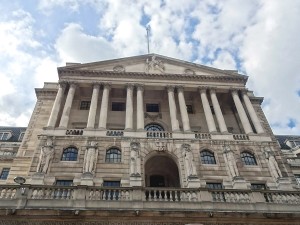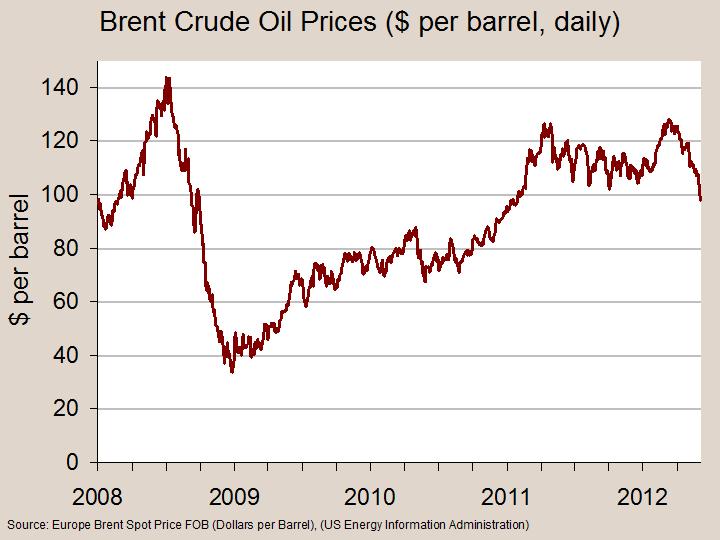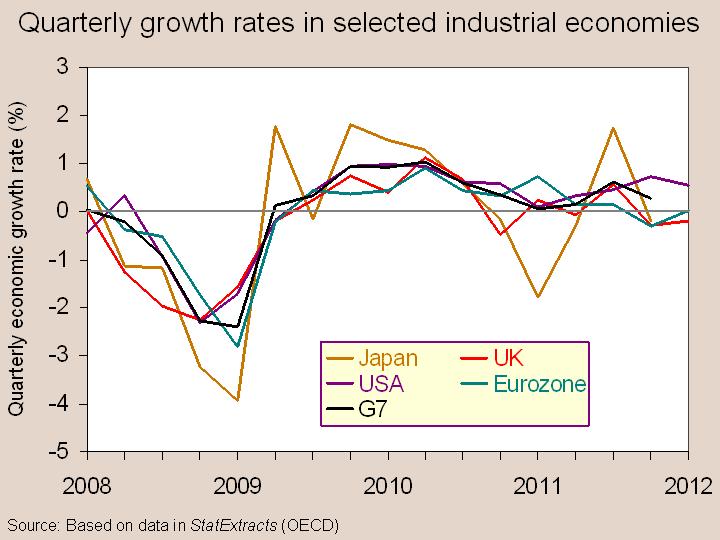 With the deepening euro crisis, the slide back into recession in many developed countries and the slowing down of fast-growing developing countries, such as China and India, confidence is waning.
With the deepening euro crisis, the slide back into recession in many developed countries and the slowing down of fast-growing developing countries, such as China and India, confidence is waning.
But just as pessimism increases, so too does uncertainty. The global economy is getting more and more difficult to forecast. So should economists give up trying to forecast? Should we rely on guesswork and hunch, or looking into crystal balls?
Bank of England representatives have been appearing before the Treasury Select Committee. And they have reiterated the consensus that things are getting more difficult to forecast. As Mervyn King said in his evidence:
There is just enormous uncertainty out there. I have no idea what is going to happen in the euro area.
 And this uncertainty is making people cautious, which, in turn, damages recovery. As Dr King went on to say:
And this uncertainty is making people cautious, which, in turn, damages recovery. As Dr King went on to say:
There is no doubt that with the additional uncertainty this year there’s evidence of people behaving in a very defensive way, being unwilling to invest and of course the most extreme example of that would be if we were to get to a liquidity trap where essentially the main assets people wanted to hold were claims on the central bank.
Part of the reason for the uncertainty about global growth prospects is uncertainty about what European leaders will decide about the future of the eurozone. Another is uncertainty about how people will respond to the uncertainty of others. But predicting how others will predict is very difficult as they will themselves be predicting what others will predict. This dilemma was observed by Keynes when observing how investors on the stock market behaved, all trying to predict what others will do, and is known as the Keynesian Beauty Contest dilemma (see also).
So are governments and central banks powerless to counteract the uncertainty and pessimism? Can they restore confidence and growth? Members of the Bank of England’s Monetary Policy Committee believe that further action can be taken to stimulate aggregate demand. Further quantitative easing and cuts in interest rates could help as, according to Dr King, we are not yet in a liquidity trap.
UK Economic Outlook Uncertain Amid Euro Zone Crisis – BOE NASDAQ, Ilona Billington (26/6/12)
BOE King: UK Not In Liquidity Trap; No Limit On QE Market News International (26/6/12)
BOE King: Unity On Loose Policy; Not Half Way Through Crisis Market News International (26/6/12)
Full Text Of BOE MPC Dale At Treasury Select Committee Market News International (26/6/12)
Recovery still five years away, Mervyn King warns The Telegraph, Philip Aldrick (26/6/12)
Governor pessimistic on recovery ShareCast, Michael Millar (26/6/12)
Bank’s King says ‘pessimistic’ about worsening economy BBC News (26/6/12)
UK economic outlook getting worse, warns Bank of England Guardian, Phillip Inman (26/6/12)
Questions
- Why is it worth economists forecasting, even if those forecasts rarely turn out to be totally accurate?
- Why is it particularly difficult in current circumstances to forecast the state of the macroeconomy 12 months hence – let alone in two or three years?
- In what ways is the global macroeconomic situation deteriorating? What can national governments do about it?
- What limits the effectiveness of government action to deal with the current situation?
- What is meant by the liquidity trap? Are we close to being in such a situation today?
- Explain what is meant by the Keynesian Beauty Contest? How is this relevant today in explaining economic uncertainty and the difficulty of forecasting the economy?
 Oil prices have been falling in recent months. By early June they had reached a 17-month low. The benchmark US crude price (the West Texas Intermediate price) fell to $83.2 at the beginning of the month, and Brent Crude (the North Sea reference price for refining into petrol) fell to $97.7 (see chart). (For a PowerPoint of the chart below, click here.)
Oil prices have been falling in recent months. By early June they had reached a 17-month low. The benchmark US crude price (the West Texas Intermediate price) fell to $83.2 at the beginning of the month, and Brent Crude (the North Sea reference price for refining into petrol) fell to $97.7 (see chart). (For a PowerPoint of the chart below, click here.)
At the same time various commodity prices have also been falling. The IMF all commodities price index has fallen by 7.2% over the past 12 months and by 6.2% in May alone. Some commodities have fallen much faster. In the 12 months to May 2012, natural gas fell by 44%, wheat by 25%, lamb by 37%, Arabica coffee by 36%, coconut oil by 45%, cotton by 47%, iron ore by 23% and tin by 29%.
Although part of the reason for the fall in the price of some commodities is increased supply, the main reason is weak world demand. And with continuing problems in the eurozone and a slowdown in China and the USA, commodity price weakness is likely to continue.
 So is this good news? To the extent that commodity prices feed through into consumer prices and impact on the rate of inflation, then this is good news. As inflation falls, so central banks will be encouraged to make further cuts in interest rates (in the cases where they are not already at a minimum). For example, the Reserve Bank of Australia cut its cash rate last week from 3.75% to 3.5%. This follows on from a cut from 4.25% on 1 May. In cases where there is no further scope for interest rate cuts (e.g. the US Federal Reserve Bank, whose interest rate is between 0% and 0.25%), then the fall in inflation may encourage a further round of quantitative easing.
So is this good news? To the extent that commodity prices feed through into consumer prices and impact on the rate of inflation, then this is good news. As inflation falls, so central banks will be encouraged to make further cuts in interest rates (in the cases where they are not already at a minimum). For example, the Reserve Bank of Australia cut its cash rate last week from 3.75% to 3.5%. This follows on from a cut from 4.25% on 1 May. In cases where there is no further scope for interest rate cuts (e.g. the US Federal Reserve Bank, whose interest rate is between 0% and 0.25%), then the fall in inflation may encourage a further round of quantitative easing.
But falling commodity prices are also a reflection of bad news, namely the low economic growth of the world economy and fears of turmoil from a possible Greek exit from the euro.
Update
A day after this was written (9/6/12), a deal was agreed between eurozone ministers to provide support of up to €100 billion for Spanish banks. This helped to reduce pessimism about the world economy, at least temporarily. Stock markets rose and so too did oil prices, by around 1%. But if pessimism increases again, then the fall is likely to resume.
Articles
Oil prices hit a 17-month low on China slowdown fears BBC News (8/6/12)
Oil gives up gains without signs of Fed move BloombergBusinessweek, Sandy Shore (7/6/12)
Oil Heads for Longest Run of Weekly Losses in More Than 13 Years BloombergBusinessweek, (8/6/12)
Gold plunges as Bernanke gives no hint of stimulus Live5News(7/6/12)
Oil Price Tumbles Below $83 on Weak Economy Money News(8/6/12)
World food price index expected to fall for May Reuters(6/6/12)
Oil price losing streak continues Guardian, Julia Kollewe (8/6/12)
Data
Spot fuel prices US Energy Information Administration
Commodity Prices Index Mundi
Crude Oil Price Index Index Mundi
Questions
- Why have crude oil prices fallen to their lowest level for 17 months?
- How can the concepts of income elasticity of demand, price elasticity of supply and price elasticity of demand help to explain the magnitude of the fall in crude oil prices?
- Would a fall in inflation linked to a fall in commodity prices be a fall in cost-push or demand-pull inflation? Explain.
- What are the macroeconomic implications of the fall in crude oil prices?
- What factors are likely to have significant impact on crude oil prices in the coming months
- Why is it difficult to predict crude oil prices over the coming months?
 With tight incomes, the first things that families tend to cut back on are the more luxury items. Extensions to houses are delayed, interior refurbishments are put off and the old car that was going to be traded in becomes something you can live with for another few years.
With tight incomes, the first things that families tend to cut back on are the more luxury items. Extensions to houses are delayed, interior refurbishments are put off and the old car that was going to be traded in becomes something you can live with for another few years.
Car sales have been adversely affected during the recession, but data for May 2012 show a positive turn. Manufacturers have said that car sales are up by 7.9% compared with May last year. According to the Society of Motor Manufacturers and Traders (SMTT), much of the increased demand has come from private sales, where the increase has been over 14%.
This data may not be the answer to the economic troubles, but it is perhaps an indication that confidence is beginning to return. However, should things go from bad to worse in the eurozone, it isn’t hard to see data for the coming months showing the opposite trend. One other key piece of information to take from this data is the growth in the sales of lower-emissions vehicles. Sales of these were up 31.8% in May 2012 compared to the same time last year. Jonathan Visscher from SMMT said:
‘The green sector is growing fast…Every car manufacturer is going to have a hybrid model on its lists by the end of this year, even Ferrari.’
The continuing upward trend in car sales is by no means guaranteed to continue, especially with things like the expected rise in fuel duty later this year and the ongoing crisis in the eurozone, with Spanish banks potentially looking for help via a bail-out in the not too distant future. The following articles consider the acceleration in car sales.
UK sees biggest annual rise in car sales for nearly 2 years Reuters (8/6/12)
New car sales accelerate ahead Press Association (8/6/12)
UK new car sales accelerated in May, say manufacturers BBC News (8/6/12)
New car sales accelerate ahead Independent, Peter Woodman (8/6/12)
Car registrations accelerate in May Financial Times, John Reed (8/6/12)
Questions
- How would you define a luxury good? What is the relationship with income?
- How could an increase in car sales benefit the economy? How could the multiplier effect have an impact?
- Which factors have contributed towards the growth in low-emissions cars?
- Sales of low-emissions cars have significantly increased. However, why is this increase
- What are some of the key things that can help to bring a recession to an end? Into which general category would you place this increase in car sales?
- Fuel duty is expected to rise later this year. How might this affect the number of new car registrations? What does your answer tell you about the cross elasticity of demand?
 In the third and final part of this blog, we look at the G8 summit at Camp David on 18 and 19 May 2012. Ways of averting the deepening global economic crisis were top of the agenda.
In the third and final part of this blog, we look at the G8 summit at Camp David on 18 and 19 May 2012. Ways of averting the deepening global economic crisis were top of the agenda.
In terms of the global economy, the leaders agreed on three main things. The first was that they supported Greece remaining in the euro. According to the communiqué:
We agree on the importance of a strong and cohesive eurozone for global stability and recovery, and we affirm our interest in Greece remaining in the eurozone while respecting its commitments. We all have an interest in the success of specific measures to strengthen the resilience of the eurozone and growth in Europe
The second was a commitment to ‘fiscal responsibility’ and the clawing down of public-sector deficits.
We commit to fiscal responsibility and, in this context, we support sound and sustainable fiscal consolidation policies that take into account countries’ evolving economic conditions and underpin confidence and economic recovery.
 The third was commitment to boosting economic growth. (Click on chart for a larger image.) On the supply side this would be through measures to stimulate productivity. On the demand side this would be through policies to stimulate investment.
The third was commitment to boosting economic growth. (Click on chart for a larger image.) On the supply side this would be through measures to stimulate productivity. On the demand side this would be through policies to stimulate investment.
(For a PowerPoint of the chart, click on the following link: Quarterly Growth.)
To raise productivity and growth potential in our economies, we support structural reforms, and investments in education and in modern infrastructure, as appropriate. Investment initiatives can be financed using a range of mechanisms, including leveraging the private sector. Sound financial measures, to which we are committed, should build stronger systems over time while not choking off near-term credit growth. We commit to promote investment to underpin demand, including support for small businesses and public-private partnerships.
But the communiqué was short on details. How will fiscal consolidation be achieved? Does this mean a continuation of austerity measures? And if so, what will be the impact on aggregate demand? Or if fiscal consolidation is slowed down, what will be the impact on financial markets?
If a growth in investment is central to the policy, what will be the precise mechanisms to encourage it? Will they be enough to combat the deflationary effect on demand of the fiscal measures?
And how will productivity increases be achieved? What supply-side measures will be introduced? And will productivity increases be encouraged or discouraged by continuing austerity measures?
Lots of questions – questions raised by the articles below.
Articles
Capitalism at a crossroads Independent (19/5/12)
 Barack Obama warns eurozone to focus on jobs and growth The Telegraph (20/5/12)
Barack Obama warns eurozone to focus on jobs and growth The Telegraph (20/5/12)
G8 Summit: World leaders push for Greece to stay in the eurozone The Telegraph, Angela Monaghan (19/5/12)
Obama sees ’emerging consensus’ on crisis Sydney Morning Herald, Ben Feller and Jim Kuhnhenn (20/5/12)
G8 leaders tout economic growth, fiscal responsibility CNN (20/5/12)
G8 focuses on Eurozone Gulf News (20/5/12)
G8 leaders back Greece amid tensions France 24 (20/5/12)
G8 splits over stimulus versus austerity Financial TimesRichard McGregor and Kiran Stacey (19/5/12)
Cameron is consigning the UK to stagnation Financial Times, Martin Wolf (17/5/12)
Time to end ‘Camerkozy’ economics Financial Times, Ed Miliband (18/5/12)
Obama: Eurozone ‘must focus on jobs and growth’ BBC News (20/5/12)
World leaders back Greece, vow to combat financial turmoil Reuters, Jeff Mason and Laura MacInnis (19/5/12)
Germany isolated over euro crisis plan at G8 meeting in Camp David Guardian, Patrick Wintour (19/5/12)
G8 leaders end summit with pledge to keep Greece in eurozone Guardian, Ewen MacAskill (19/5/12)
G8 summit ends with few tangible results Xinhua, Sun Hao (20/5/12)
Final communiqué
Camp David DeclarationG8 (19/5/12)
Questions
- To what extent are economic growth and fiscal consolidation (a) compatible; (b) incompatible objectives? How might a Keynesian and a new classical economist respond to these questions?
- What supply-side measures could be introduced by the EU?
- Why might dangers of protectionism increase in the coming months?
- What would be the impact of a Greek default and exit from the eurozone on other eurozone economies?
- What monetary policy changes could be introduced by the eurozone governments and the ECB in order to ease the sovereign debt crisis of countries such as Grecce, Spain, Portugal, Italy and Ireland?
 This has been a week of gloomy prognostications. On Wednesday 16 May, the Bank of England published its quarterly Inflation Report – and it makes worrying reading.
This has been a week of gloomy prognostications. On Wednesday 16 May, the Bank of England published its quarterly Inflation Report – and it makes worrying reading.
The forecast of UK economic growth for 2012 has been reduced from 1.2% in the previous report to 0.8%. But the rate of inflation is forecast to remain above the 2% target well into next year. However, at the two-year horizon, inflation is now forecast to be 1.6% – below the target, thus giving the MPC scope for further quantitative easing.
In the introduction to the report, the Governor, Mervyn King, writes:
Over the past year or so, two factors have hampered the recovery and rebalancing by more than expected. First, higher-than-expected world commodity and energy prices have squeezed real take-home pay, dampening consumption growth. Second, credit conditions, far from easing, have in some cases become tighter. The direct and indirect exposures of UK banks to the euro-area periphery have affected funding costs as the challenges of tackling the indebtedness and lack of competitiveness in those countries have intensified.
And at the news conference launching the report, he said:
We have been through a big global financial crisis, the biggest downturn in world output since the 1930s, the biggest banking crisis in this country’s history, the biggest fiscal deficit in our peace time history and our biggest trading partner – the euro area – is tearing itself apart without any obvious solution.
The idea that we could reasonably hope to sail serenely through this with growth close to the long run average and inflation at 2% strikes me as wholly unrealistic. We’re bound to be buffeted by this and affected by it.
 The following articles look at the Bank of England’s predictions and at the challenges facing the UK economy as the crisis in the eurozone deepens and as inflation in the UK remains stubbornly above target. They also look at the issue of the extent to which capacity has been lost as a result of the continuing weakness of the UK economy. As The Economist article states:
The following articles look at the Bank of England’s predictions and at the challenges facing the UK economy as the crisis in the eurozone deepens and as inflation in the UK remains stubbornly above target. They also look at the issue of the extent to which capacity has been lost as a result of the continuing weakness of the UK economy. As The Economist article states:
Business surveys suggest only a small proportion of firms are operating below capacity. That finding looks odd given the economy’s output is still 4% below its level at the start of 2008, and is much farther below the level it would have reached if GDP growth had continued at its long-term rate. The picture painted by surveys could be right if a chunk of the economy’s potential has been written off for good. But Sir Mervyn King, the bank’s governor, doubts this. There is “no obvious reason” why the economy could not rejoin its pre-crisis path, though it might take a decade or two to get there, he said on May 16th.
We look in more detail at the question of lost capacity in Part 2.
Articles
 Bank of England cuts growth forecasts: Sir Mervyn King’s speech in full The Telegraph (16/5/12)
Bank of England cuts growth forecasts: Sir Mervyn King’s speech in full The Telegraph (16/5/12)
Bank of England sees inflation up and growth falling Independent, Ben Chu (17/5/12)
Hard going The Economist (19/5/12)
Bank of England optimism dented again Financial Times, Chris Giles (16/5/12)
Eurozone is ‘tearing itself apart’, says Mervyn King. True, but the UK’s problems are as intractable as ever The Telegraph, Philip Aldrick (16/5/12)
Inflation Report
Inflation Report: portal page Bank of England
Inflation Report: May 2012 Bank of England (16/5/12)
Additional Data
Statistical annex to European Economy. Spring 2012 European Commission, Economic and Financial AffairsAnnual macro-economic database European Commission, Economic and Financial Affairs (11/5/12) (see particularly section 6.5)
Forecasts for the UK economy HM Treasury
Questions
- What explanations are given for the rate of CPI inflation remaining persistently above the 2% target?
- Why have the prospects for economic growth worsened since the publication of the February Inflation Report?
- How might it be possible to have a narrowing (negative) output gap and yet a stagnant economy?
- Why may capacity have been lost since the financial crisis of 2008?
- Why has M4 declined despite the programme of quantitative easing? (See M4 in record fall despite QE.)
- What scope is there for monetary policy in achieving faster economic growth without pushing inflation above the 2% target?
 With the deepening euro crisis, the slide back into recession in many developed countries and the slowing down of fast-growing developing countries, such as China and India, confidence is waning.
With the deepening euro crisis, the slide back into recession in many developed countries and the slowing down of fast-growing developing countries, such as China and India, confidence is waning. And this uncertainty is making people cautious, which, in turn, damages recovery. As Dr King went on to say:
And this uncertainty is making people cautious, which, in turn, damages recovery. As Dr King went on to say:






